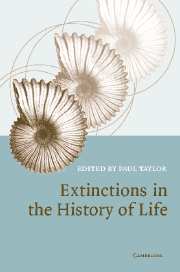Book contents
- Frontmatter
- Contents
- Notes on contributors
- Preface
- 1 Extinction and the fossil record
- 2 Extinctions in life's earliest history
- 3 Mass extinctions in plant evolution
- 4 The beginning of the Mesozoic: 70 million years of environmental stress and extinction
- 5 Causes of mass extinctions
- 6 The evolutionary role of mass extinctions: disaster, recovery and something in-between
- Glossary
- Index
- References
6 - The evolutionary role of mass extinctions: disaster, recovery and something in-between
Published online by Cambridge University Press: 18 December 2009
- Frontmatter
- Contents
- Notes on contributors
- Preface
- 1 Extinction and the fossil record
- 2 Extinctions in life's earliest history
- 3 Mass extinctions in plant evolution
- 4 The beginning of the Mesozoic: 70 million years of environmental stress and extinction
- 5 Causes of mass extinctions
- 6 The evolutionary role of mass extinctions: disaster, recovery and something in-between
- Glossary
- Index
- References
Summary
INTRODUCTION
The fossil record is punctuated by extinction events at all scales, from the loss of one or two fish species with the drying of a lake, to the wholesale disappearance of dinosaurs or ammonites at the end of Cretaceous period 65 million years (Ma) ago. The handful of events that are global in scale and affect a broad spectrum of organisms are termed mass extinctions. Although most research has centred on the causes of mass extinctions (Chapter 5), there has also been a growing appreciation of the evolutionary consequences of mass extinctions. The evolutionary bursts that follow mass extinctions may be as important as the extinction events themselves in setting the tone of the post-extinction world, as new or previously obscure lineages take advantage of the opportunities opened up by the demise of dominant groups. The most familiar example of this came at the end of the Cretaceous Period. Dinosaurs and mammals originated almost simultaneously in the Triassic Period about 225 Ma ago, and the dinosaurs dominated terrestrial ecosystems for over 120 Ma while the mammals lived in the nooks and crannies of the dinosaurs' world. The dinosaurs became extinct 65 Ma ago, along with many other lineages on land and in the sea, bringing the Mesozoic Era to a close, and within the first 10 or 15 Ma of the Cenozoic, a rich mammalian fauna diversified on the land, bats took to the sky and whales to the sea.
- Type
- Chapter
- Information
- Extinctions in the History of Life , pp. 151 - 178Publisher: Cambridge University PressPrint publication year: 2004
References
- 11
- Cited by



